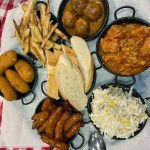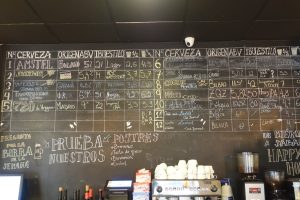Sacromonte is a district of Granada that belongs to the old city, but shows a completely different way of life. Here are the famous dwelling caves of the Spanish gypsies/gitanos, which can be visited in the Museo Cuevas del Sacromonte.
The footpath to Sacromonte always leads uphill and offers a fantastic view of the Alhambra, which lies high above the city. Only from this side I became aware of the size and mightiness of the complex.

We walked past some bars and restaurants that attract visitors especially in the evening hours with their flamenco shows and of course the view of the then illuminated Alhambra.
In Sacromonte, a large group of Roma, or Spanish gypsies (Gitanos), settled in the 15th century.
Museo Cuevas del Sacromonte
The museum is located slightly above the residential buildings and is accessible only on foot. The path from the street (a bus also stops there) is steep and paved with uneven stones. You have to be good on foot to get up there.

The Museo Cuevas del Sacromonte is an open-air museum dedicated to cave dwellings, flamenco and the culture of the Spanish gypsies who once lived there.

Arranged around a central square are individual caves that can be visited. The caves were not formed naturally, but were driven into the mountain by hand. Thus, it was possible to adjust the size to the needs of the inhabitants.

Cave dwellings in Sacromonte
The entrance to each of the cave dwellings in Sacromonte is whitewashed and a door is set into the rock. Most of the time you have to climb 1-2 steps to enter the caves. In the Museo Cuevas del Sacromonte there are several rooms to visit, each with a different theme in terms of content.
First we entered a cave, which is actually furnished like an apartment. Typically, in these cave apartments, the kitchen area of the apartment is located directly behind the entrance door. This allowed for good air circulation while cooking. In the middle area is the living area of the family and the connection is the bedroom.

If the family needed more sleeping quarters, they simply extended the cave deeper into the mountain. Actually, I think it looked quite cozy in the living cave. The whitewashed walls brought some brightness and the bed with its colorful ceiling brought color into the windowless room.

The immediate next level was the family’s stable. Here were housed not only the animals, but also tools and animal feed. Since animals in a stable are known to produce a lot of heat, there was usually a small connecting shaft to the living cave, which transported the heat there and so the family used a natural heat source as heating.
There are even extra caves where the community cooked and baked together.

In other caves you learn about the different activities of the inhabitants: weaving baskets, metalworking, pottery, weaving fabrics. I especially liked the pottery with the beautiful patterns.

The theme of flamenco is given special attention. The caves of the former gypsy quarter are considered the home of flamenco in Granada. Here, flamenco was danced mainly at gypsy weddings the so-called zambras. The Gitanos developed their own style, a mixture of traditional Spanish flamenco and Arabic belly dance.

A closer look at the outdoor area is also worthwhile. There is a nature trail here. There you can get information about the flora and fauna as well as the agriculture of this area.
Address:
Barranco de los Negros,
Sacromonte Granada
Opening hours:
5. October – 14. March:
daily 10 – 18 h
15. March – 14. October:
daily 10 – 20 h
Entrance fees:
Adults: 5,-€








Leave a Reply